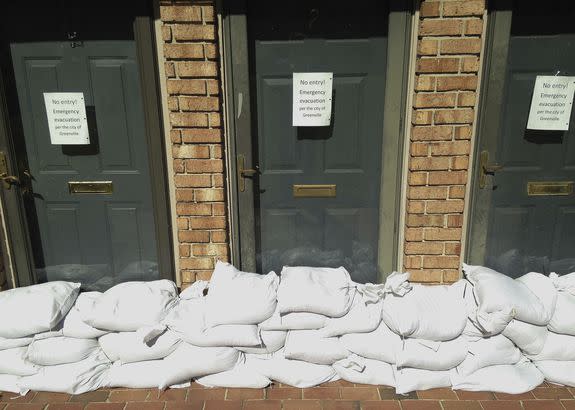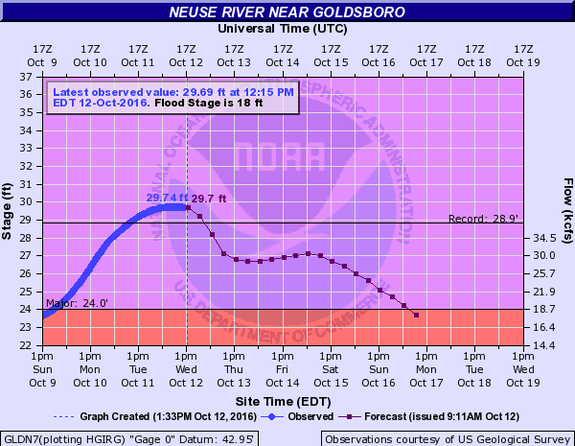Worst flooding is yet to come in parts of North Carolina, governor warns

The worst flooding could be yet to come in several parts of North Carolina as rivers continue swelling to record levels in the wake of Hurricane Matthew.
Gov. Pat McCrory warned on Wednesday that floodwaters had not yet peaked in parts of Pender and Lenoir counties, where officials said they expect cresting rivers to cause devastating flooding. The flooding comes after Hurricane Matthew drenched the Southeast with nearly 14 trillion gallons of rainfall, with the heaviest amounts falling on already saturated ground in North and South Carolina.
"Our recovery efforts are in full swing and we are making progress, but we still have a long way to go," the Republican governor said in a statement.
SEE ALSO: North Carolina flooding is so severe that rescuers need sonar to locate cars, victims
Thousands of people have been ordered to evacuate in eastern parts of the state. Officials warned that rising floodwaters could wash out roads and close bridges, leaving residents stranded in their waterlogged communities.

Image: P Photo/Jonathan Drew
In the city of Greenville, police officers and firefighters this week roamed the streets in military trucks, shouting an urgent message from bullhorns: Get out before the floodwaters arrive.
Orange traffic cones and police tape throughout Greenville discouraged people from entering the city, while police stationed at the edge of the evacuation zone monitored who came and went.
"I continue to urge citizens in low-lying areas to please stay away from flooded water as rivers continue to reach record levels," McCrory said .
To put things into perspective: the Cape Fear River before and after #HurricaneMatthew #Fayetteville pic.twitter.com/263dvjlyiq
— Keely J. Warren (@keelyjolene) October 11, 2016
Deaths from Hurricane Matthew now stand at 19 in North Carolina, and one person is still reported as missing, the governor said.
Nearly 2,300 people have been saved by search-and-rescue teams working across eastern and central North Carolina, and thousands of people are still seeking safety in shelters.
Hurricane Matthew made U.S. landfall last week as a Category 1 storm, after slamming Haiti and affecting Cuba and Florida as a Category 4 hurricane.
The storm landed on Saturday near McClellanville, South Carolina, bringing heavy wind and dangerous flooding to parts of eastern Florida, Georgia and South Carolina.
#hurricanematthew @jdiesel_420 @roamyroam
A video posted by Jessi Loren Roam (@jessicafuckinroam) on Oct 11, 2016 at 8:52am PDT
In the U.S., North Carolina is suffering some of the worst damage from Matthew as the state's rivers, already bloated after weeks of unusually high rainfall, approached or exceeded record heights.
The Neuse River rose to 29.74 feet in the city of Goldsboro between Tuesday and Wednesday, beating the existing record of 28.9 feet, which was set in 1999 when Hurricane Floyd slowly skirted North Carolina's coast.

Image: national weather service
Floyd wracked up $3 billion in damage and destroyed 7,000 homes in the state. Matthew is similarly expected to cause billions' in economic damages and destroy thousands of North Carolina homes, although the full extent of the disaster is still unclear.
The Neuse River is also expected to crest at 28 feet in the city of Kinston between Oct. 14 and Oct. 15, beating the 1999 record of 27.7 feet.
Rising rivers aren't the only thing North Carolina residents should fear. The National Weather Service in Wilmington warned that fire ants also pose a risk during flooding events.
Fire ants pose a serious hazard during flooding and during recovery. Please follow this advice from OSHA. pic.twitter.com/5delCJxrkP
— NWS Wilmington NC (@NWSWilmingtonNC) October 12, 2016
The venomous ants can rapidly assemble themselves into floating rafts as a flood survival mechanism, stinging and biting people as they roam.
The Associated Press contributed reporting.
